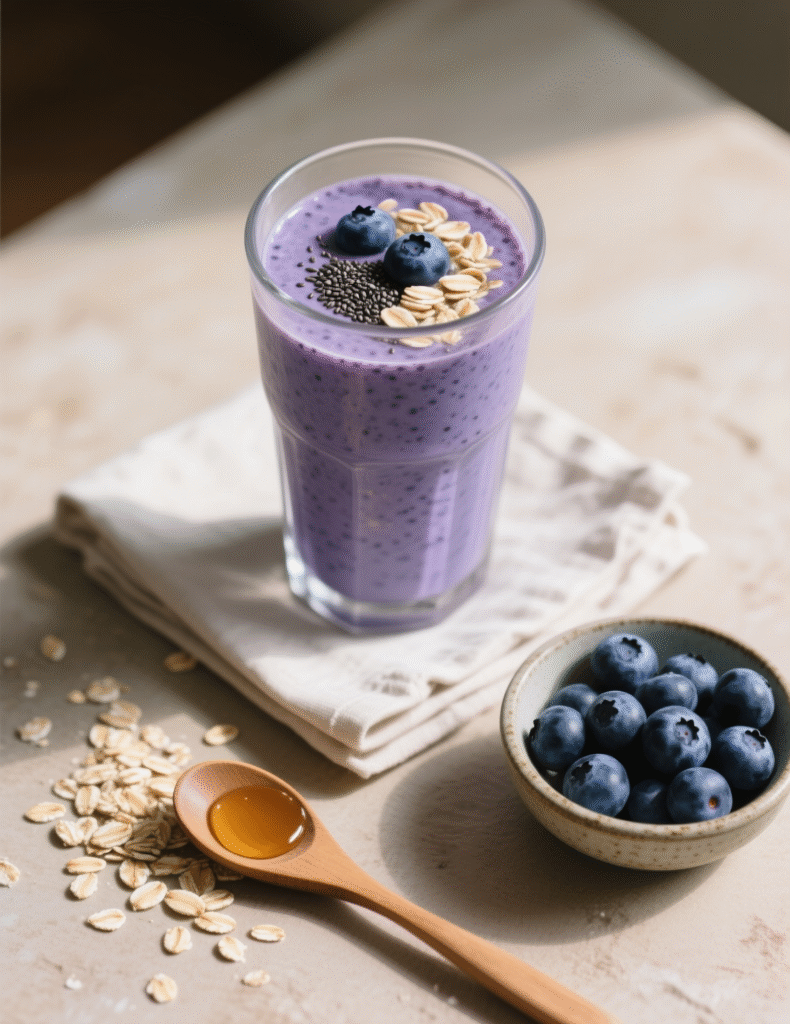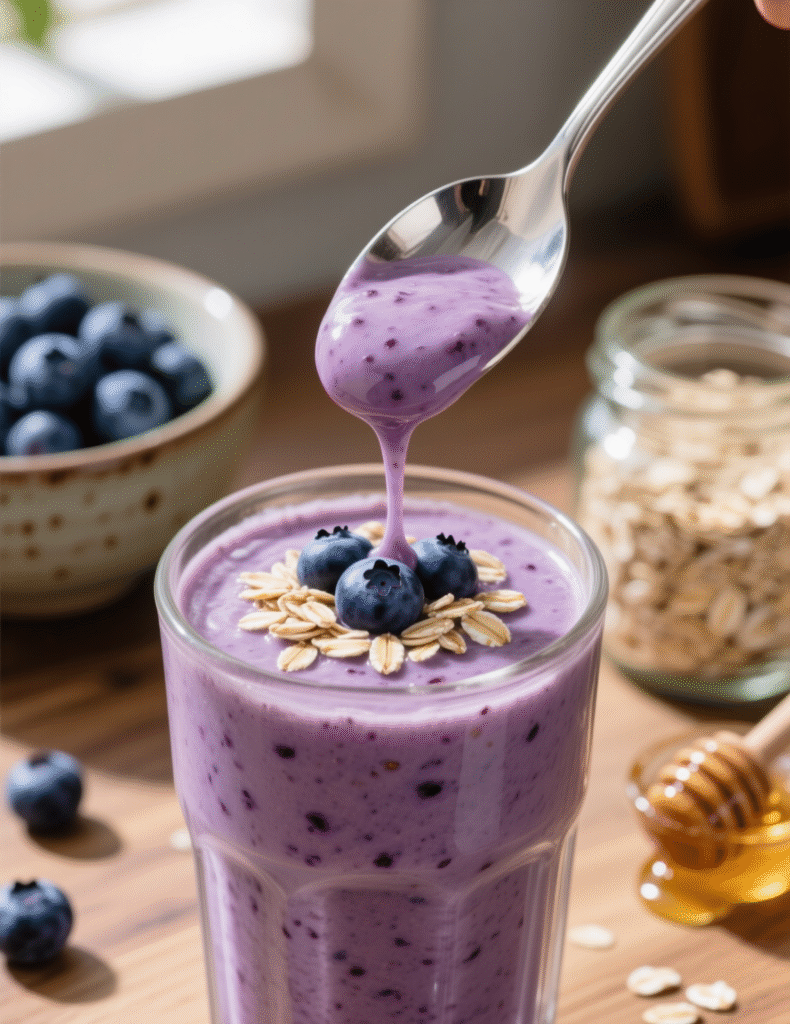Mornings can be messy. Rushed coffee, skipped breakfast, energy dips before noon—it’s the cycle most people know too well. A blueberry oatmeal smoothie may not solve life’s chaos, but it does give a steady push in the right direction. It’s a drink with brains and heart—nutritional power with a taste people actually crave.
Why Blueberries and Oats Belong in a Glass
Blueberries aren’t just for muffins. They’re loaded with anthocyanins, the pigments that give them that deep blue-purple hue. These compounds fight oxidative stress like little warriors. Studies have linked regular blueberry consumption with improved memory and reduced risk of cardiovascular disease.
Oats, on the other hand, don’t look glamorous, but they pack a punch. A single half-cup of rolled oats gives about 4 grams of fiber. The real kicker is beta-glucan, a soluble fiber shown to lower LDL cholesterol. When blended, oats bring creaminess, body, and slow-release carbs—keeping energy levels from crashing two hours later.
Mix them together, and you get synergy. The fruit adds antioxidants. The oats provide fiber and sustained fuel. The result is a smoothie that behaves more like a full meal than a quick sip.
The Nutritional Science at Play
A typical blueberry oatmeal smoothie can deliver close to 300–400 calories, depending on add-ins. That’s enough for a light breakfast. Protein usually sits between 8–15 grams if you add yogurt or protein powder.
Blueberries: one cup has 84 calories, 21 grams carbs, and nearly 4 grams fiber. They also carry vitamin C, vitamin K, and manganese.
Oats: half a cup of rolled oats is about 150 calories, 5 grams protein, and 27 grams carbs. More importantly, they’re low glycemic—your blood sugar rises slowly.
Blend them with milk or yogurt, and you’ve got a balanced macronutrient profile. Carbs for fuel, protein for repair, fat for satiety, and fiber for gut health. Dietitians often say: the best breakfasts tick all those boxes. This one does without overthinking.

The Core Recipe
Every smoothie needs a blueprint. Here’s the reliable version most professionals recommend:
Ingredients
- 1 cup frozen blueberries
- ½ cup rolled oats (raw or lightly soaked)
- 1 medium banana
- 1 cup milk (dairy or unsweetened almond/soy)
- ½ cup plain Greek yogurt (optional for protein)
- 1 teaspoon honey or maple syrup (optional, if fruit isn’t sweet enough)
- Pinch of cinnamon
Instructions
- Add oats first to the blender. They grind smoother when they hit the blades directly.
- Toss in blueberries, banana, milk, and yogurt.
- Blend on high until creamy. Stop once or twice to scrape down sides if oats cling.
- Taste and adjust sweetness. Pour and serve cold.
Prep time? Barely 5 minutes. Cleanup? One jug and a spoon. That’s why this recipe survives in busy households.
Texture Matters More Than People Think
A common mistake is using raw oats without enough liquid. The smoothie turns thick and chalky. Professionals often soak oats for 10 minutes in milk before blending. It softens the starches, giving a silkier mouthfeel.
Frozen blueberries also change the game. Fresh ones give flavor, but frozen berries thicken and chill the drink. A smoothie should drink cold, not lukewarm like a sad porridge. The frozen route wins nine out of ten times.
Bananas do double duty too. They sweeten naturally and act as an emulsifier. Without them, the smoothie can taste flat, even sour, especially if yogurt is included.
Variations Professionals Actually Use
Recipes evolve in real kitchens. Here are some tested twists:
- Protein Boost: Add one scoop vanilla whey or pea protein. This can raise protein to 25 grams—ideal for athletes.
- Nutty Power: Toss in a tablespoon almond butter. Adds healthy fats and a toasty undertone.
- Greens Upgrade: A handful of spinach blends seamlessly. The color turns murky, but taste remains berry-forward.
- Gut Health: Kefir instead of yogurt adds probiotics and tang.
- Dessert Spin: Swap milk for coconut milk and sprinkle cacao nibs on top.
These variations help professionals cater to clients with specific needs—weight management, muscle recovery, gut support.
The Role of Glycemic Control
Smoothies often get criticized for sugar spikes. A fruit-only smoothie can load 40+ grams sugar in one glass. The blueberry oatmeal version avoids that pitfall.
Why? Oats and yogurt slow digestion. Fiber and protein blunt the glycemic impact. Blood sugar rises gently instead of shooting up like fireworks. For people with insulin resistance, this makes a huge difference. In clinical studies, breakfasts rich in beta-glucan (from oats) showed improved glucose response across the day.
Hydration and Satiety—The Overlooked Angles
It’s easy to forget smoothies are mostly liquid. A cup of milk and a cup of berries already add up to significant fluid. That helps with morning hydration—often neglected.
Satiety is another point. Fiber from oats and fruit keeps the stomach fuller longer than juice or coffee alone. Some clients report staying full until early afternoon. In a controlled trial published in the Journal of Nutrition, oatmeal breakfasts scored higher in satiety compared to ready-to-eat cereal with identical calories. Smoothies with oats can mimic that effect.
Common Mistakes That Ruin It
People overcomplicate smoothies. They throw in chia, flax, three nut butters, collagen powder, honey, dates, and suddenly the drink is 700 calories. It stops being a light breakfast and becomes a calorie bomb.
Another mistake: skipping the protein. A smoothie with just fruit and oats may taste good but won’t keep hunger away. Yogurt or protein powder balances the equation.
Also, blending too long heats the drink. High-speed blenders create friction. Professionals pulse in intervals to keep smoothies cold. Temperature changes flavor perception—warm smoothies taste dull.
Who Should Drink This
Athletes appreciate it post-workout for glycogen replenishment. Office workers use it as a quick breakfast during commutes. Older adults benefit too—easy to digest, nutrient-dense, not heavy.
For children, it’s a stealthy way to add oats and fruit. A little cocoa powder hides the spinach if parents want extra greens. For diabetics, portion control matters, but the balance of carbs and fiber is far safer than juice-based blends.
Real-World Use Cases
Dietitians in hospital settings often recommend oat smoothies for patients with poor appetite. The liquid format helps them consume calories without feeling overwhelmed by solids.
Professional athletes? Many use oatmeal-based shakes after endurance events. Carbs replenish glycogen, blueberries reduce inflammation, protein repairs muscle. Serena Williams once shared her love of berry smoothies with oats in training seasons.
Corporate wellness programs also push recipes like these. They’re easy to demo, require minimal equipment, and align with “better breakfast” campaigns.

What Research Backs This Up
Blueberry studies are abundant. A 2019 review in Advances in Nutrition found consistent evidence linking blueberry intake to improved vascular function. Another in Nutrients 2020 tied blueberries to better cognitive performance, particularly in older adults.
Oats aren’t far behind. A meta-analysis in American Journal of Clinical Nutrition showed daily beta-glucan intake (3 grams) lowers LDL cholesterol by 5–10%. That’s clinically significant.
Together, the pairing covers both cardiovascular and metabolic health. It’s not hype—it’s hard science dressed in a tasty package.
The Emerging Trend: Functional Smoothies
We’re seeing a shift from casual smoothies to functional smoothies. Not just drinks, but targeted nutrition solutions. Blueberry oatmeal fits perfectly into this category. It addresses heart health, digestion, cognition, and satiety—all in one go.
The trend also leans toward minimalism. Instead of 15 superfoods tossed in one blender, professionals now highlight 2–3 star ingredients. Consumers trust simpler, science-backed recipes over “kitchen sink” concoctions.
Small Professional Tips That Make a Big Difference
- Always blend oats first for a finer texture.
- Use frozen fruit to control thickness without watering down.
- Add cinnamon or nutmeg for flavor complexity.
- Taste test before sweetening. Bananas vary in ripeness and can carry enough sugar alone.
- Serve immediately. Oats continue to thicken the smoothie if left sitting for too long.
Conclusion
The blueberry oatmeal smoothie is more than a trendy recipe. It’s grounded in nutritional science, easy enough for a busy morning, yet robust enough for professional recommendations. Blueberries deliver antioxidants, oats bring fiber and satiety, and together they create a balance many breakfasts lack.
The real value lies in versatility. It can suit athletes, office workers, kids, or patients in recovery. It can lean sweet or tangy, light or protein-heavy. That flexibility keeps it timeless, not just another health fad.
For professionals guiding clients, it’s a recipe worth teaching. For anyone at home, it’s a breakfast worth blending. One glass, five minutes, and a morning that doesn’t just start—but starts right.
FAQs
What makes blueberry oatmeal smoothies healthy?
They combine antioxidants from blueberries with fiber-rich oats for balanced energy and heart health.
Can I use fresh blueberries instead of frozen?
Yes, but frozen berries give a creamier, chilled texture.
Do I need to cook the oats before blending?
No, rolled oats can go in raw, though soaking softens them.
How many calories are in one serving?
Usually between 300–400 calories, depending on add-ins.
Is this smoothie good for weight loss?
Yes, it’s filling and nutrient-dense, helping curb snacking.
Can diabetics drink blueberry oatmeal smoothies?
Yes, if portioned carefully since oats and protein help control sugar spikes.
What’s the best liquid to use?
Unsweetened almond milk, dairy milk, or even kefir all work well.
Can I make it the night before?
Not ideal, as oats thicken overnight and change texture.
What protein options can I add?
Greek yogurt, whey, or plant-based protein powders are excellent.
Are there vegan variations of this smoothie?
Yes, swap dairy yogurt and milk for plant-based versions.

Mariana is a passionate home cook who creates delicious, easy-to-follow recipes for busy people. From energizing breakfasts to satisfying dinners and indulgent desserts, her dishes are designed to fuel both your body and hustle.
When she’s not in the kitchen, she’s exploring new flavors and dreaming up her next recipe to share with the Foodie Hustle community.

